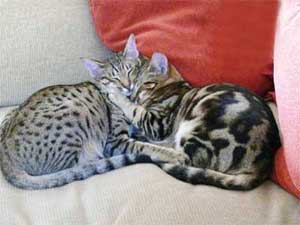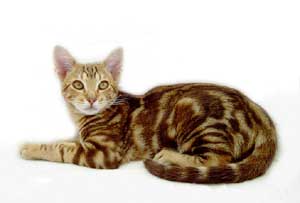|
|||||
| The only UK Club dedicated exclusively to the Ocicat and Ocicat Classic | |||||
| Header photographs © Robert Fox | |||||
WELFARE If you know of an Ocicat welfare issue, or an adult Ocicat needing a new home...
|
The Ocicat Classic
The Ocicat Classics are extremely beautiful, and it is hoped that their recognition as a separate breed alongside their spotted relatives will be a success. Apart from the beautiful coat pattern there are no other differences from the Ocicat itself. The Classic pattern can occur in all 12 of the Ocicat colours * Please see the NEWS PAGE for an update on the Ocicat Classic Breed Promotion * A Brief description of the Classic Pattern All markings to be clearly defined and dense. On the forehead there should be a letter ‘M’ giving the impression of a frown. An unbroken stripe should run from the outer corner of the eye; narrow lines on cheeks. The neck and upper chest to have unbroken necklaces, the more the better. The edges of the ears to be the same colour as the markings with a central patch of ground colour resembling a thumbprint. A series of lines should run from above the 'M' markings over the top of the head and extend to the shoulder markings. The shoulder markings form the outline of a butterfly, when viewed from above. Both upper and lower 'wings' to be clearly defined with the central areas broken by small areas of ground colour. On the back there should be an unbroken line should run down the spine from the butterfly to the tail, and there should be a stripe on either side of this and running parallel to it; these stripes should be separated from each other by stripes of the ground colour. On each flank there should be an 'oyster shaped' patch which should be surrounded by one or more unbroken rings. The tail should have complete rings, as numerous as possible, with the tip of the tail being the same colour as the markings. The legs should be barred evenly with bracelets from the body markings to the toes, which are spotted. The abdominal regions should also be spotted. Ground colour and markings should be evenly balanced and both sides of the cat should ideally have identical markings.
|
||||
|
|||||
Home | The Ocicat | Ocicat Classic | Show Results | Hall of Fame | Breeders | Ocicat Show |
|||||
|
All content copyright The Ocicat Club UK © 2002-2014 All rights reserved |
|||||
 Increasingly over recent years Ocicats with the Classic coat pattern (Ocicat Classics) have been appearing in Ocicat litters in the UK. The Classic pattern was introduced in the early origins of the Ocicat by the American Shorthair breed, this breed further contributed body substance and the silver colour gene.
Increasingly over recent years Ocicats with the Classic coat pattern (Ocicat Classics) have been appearing in Ocicat litters in the UK. The Classic pattern was introduced in the early origins of the Ocicat by the American Shorthair breed, this breed further contributed body substance and the silver colour gene.